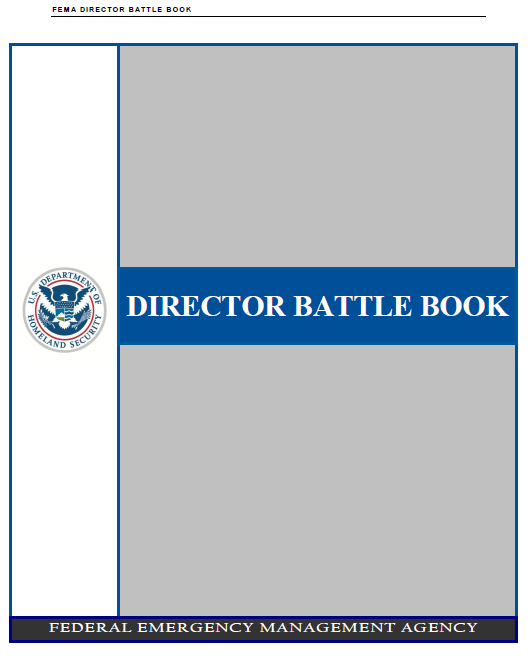FEMA DIRECTOR BATTLE BOOK
- 65 pages
- June 25, 2010
The purpose of this ―battle book is to provide the FEMA Director with background information and recommended checklist actions on scenarios that may require a significant response operation under the National Response Plan. This document is intended to serve as a ―one stop reference that includes information on the agency’s emergency teams and resources.
…
G. RADIOLOGICAL OR NUCLEAR INCIDENT
- BACKGROUND:
- An incident involving the release of radiation and/or the denotation of a nuclear devise may be accidental or intentional. Generally, the most likely incident would involve the accidental or intentional release of radioactive material rather than a nuclear explosion.
- SPECIFIC CHALLENGES / RESOURCE ISSUES:
- The number of FEMA response teams capable of operating in a contaminated environment is limited. It is likely that the need will exceed the available resources.
- The chain-of-command and coordination among the Federal agencies may become very complex, particularly in terrorist related or suspected incidents.
- The Nuclear/Radiological Incident Annex to the National Response Plan is very unclear on the processes of how an incident will be declared an Incident of National Significance, which by definition makes DHS the lead Federal Agency.
- Treating homes within contaminated areas that are ―intact: How will our traditional human services programs be adapted to these circumstances?
- The issue of what is considered ―clean in terms of decontamination is likely to be contentious. The general public may be unwilling to accept the assurances of the experts that the area affected is ―safe.
- Long-term monitoring of those exposed to radiation.
- An incident in the National Capitol Region (NCR) may have severe consequences on Agency Headquarters and their capability to continue operations.
- Effectively communicating with the public on the risks associated with radiation. Many people may seek medical treatment in spite of relatively low exposures.
- Decontamination of people within the impacted area.
- Denotation of a nuclear device will cause catastrophic damage to the immediate area (area impacted dependent upon the yield of device) and potential widespread panic among the population
…
I. TERRORIST ATTACKS
- BACKGROUND:
- The Federal Bureau of Investigation (FBI) defines terrorism as the unlawful use of force or violence committed by an individual against persons or property to intimidate or coerce a government, the civilian population, or any segment thereof, in furtherance of political or social objectives. Force may involve many types of weapons and scenarios. Weapons of Mass Destruction (WMD) are defined in 18 U.S.C. § 2332a to include explosive, incendiary, and nuclear, biological, and chemical (NBC) materials and weapons. There are continuing concerns that terrorists may use so-called ―dirty bombs‖ that would use a conventional explosion to disperse radioactive material over a large area. Attacks using various chemical agents are also a major concern. It is considered unlikely that terrorists would be able to effectively use a biological agent as a means of creating mass casualties. It is likely that terrorist will attempt to attack ―soft targets‖ with the specific purpose of inflicting as many casualties as possible. Soft targets may include transportation centers, transit systems, and public events.
- SPECIFIC CHALLENGES / RESOURCE ISSUES:
- Generally, a terrorist attack will occur with no warning. The timeframe for effectively deploying critical search and rescue and medical teams will be condensed. Decisions will need to be made with very limited information.
- A terrorist attack may cause panic among the general population and prompt fears of additional attacks.
- Transportation systems (particularly air) may have been curtailed or suspended their operations complicating the process of deploying teams and resources.
- The line of demarcation between the need to respond versus the need to conduct law enforcement investigations at the incident location may not always be clear.
- For a terrorist attack, the FBI is the lead Federal Agency for the law enforcement and investigation, whereas the DHS is the overall lead Federal Agency. The federal chain-of-command may not always be clearly defined.
- An incident within the National Capitol Region (NCR) may have major impacts on continuing operations at the headquarters.
- A terrorist attack may involve biological, chemical, or radioactive agents or materials. Each will pose unique operational challenges. Many of the Federal response teams are not trained or equipped to operate in contaminated environments.

